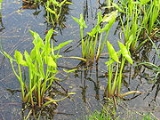
Peltandra virginica
Encyclopedia
Peltandra virginica is a plant of the Araceae
family known by the common names green arrow arum and tuckahoe. It is native to parts of eastern North America, where it is common in wet areas. It can be found elsewhere in North America as an introduced species
and often an invasive plant.
This is an aquatic
perennial herb growing from a large clumpy rhizome
and producing many large leaves. An individual leaf may have a petiole
nearly a meter long and a blade half a meter in length. The leaves are quite variable in shape and size, but they are often generally arrowhead-shaped.
The inflorescence
bears male and female flowers, as well as sterile flowers. The flower varies from whitish to greenish to yellow. The fruit is a brown berry
containing a few seeds within a clear gelatinous pulp.
The fly Elachiptera formosa breeds in this plant, mating on the inflorescence and laying eggs there, so the larva
e can feed on the rotting spadix
.
The plant contains calcium oxalate
crystals, making it unpalatable. Native Americans used most parts of the plant for food, however, cooking it for hours first to make it safe to eat.
Araceae
Araceae are a family of monocotyledonous flowering plants in which flowers are borne on a type of inflorescence called a spadix. The spadix is usually accompanied by, and sometimes partially enclosed in, a spathe or leaf-like bract. Also known as the Arum family, members are often colloquially...
family known by the common names green arrow arum and tuckahoe. It is native to parts of eastern North America, where it is common in wet areas. It can be found elsewhere in North America as an introduced species
Introduced species
An introduced species — or neozoon, alien, exotic, non-indigenous, or non-native species, or simply an introduction, is a species living outside its indigenous or native distributional range, and has arrived in an ecosystem or plant community by human activity, either deliberate or accidental...
and often an invasive plant.
This is an aquatic
Aquatic plant
Aquatic plants are plants that have adapted to living in aquatic environments. They are also referred to as hydrophytes or aquatic macrophytes. These plants require special adaptations for living submerged in water, or at the water's surface. Aquatic plants can only grow in water or in soil that is...
perennial herb growing from a large clumpy rhizome
Rhizome
In botany and dendrology, a rhizome is a characteristically horizontal stem of a plant that is usually found underground, often sending out roots and shoots from its nodes...
and producing many large leaves. An individual leaf may have a petiole
Petiole (botany)
In botany, the petiole is the stalk attaching the leaf blade to the stem. The petiole usually has the same internal structure as the stem. Outgrowths appearing on each side of the petiole are called stipules. Leaves lacking a petiole are called sessile, or clasping when they partly surround the...
nearly a meter long and a blade half a meter in length. The leaves are quite variable in shape and size, but they are often generally arrowhead-shaped.
The inflorescence
Inflorescence
An inflorescence is a group or cluster of flowers arranged on a stem that is composed of a main branch or a complicated arrangement of branches. Strictly, it is the part of the shoot of seed plants where flowers are formed and which is accordingly modified...
bears male and female flowers, as well as sterile flowers. The flower varies from whitish to greenish to yellow. The fruit is a brown berry
Berry
The botanical definition of a berry is a fleshy fruit produced from a single ovary. Grapes are an example. The berry is the most common type of fleshy fruit in which the entire ovary wall ripens into an edible pericarp. They may have one or more carpels with a thin covering and fleshy interiors....
containing a few seeds within a clear gelatinous pulp.
The fly Elachiptera formosa breeds in this plant, mating on the inflorescence and laying eggs there, so the larva
Larva
A larva is a distinct juvenile form many animals undergo before metamorphosis into adults. Animals with indirect development such as insects, amphibians, or cnidarians typically have a larval phase of their life cycle...
e can feed on the rotting spadix
Spadix
In botany, a spadix is a type of spike inflorescence having small flowers borne on a fleshy stem. Spadix are typical of the Family Araceae known as arums or aroids...
.
The plant contains calcium oxalate
Calcium oxalate
Calcium oxalate is a chemical compound that forms needle-shaped crystals, known in plants as raphides. A major constituent of human kidney stones, the chemical is also found in beerstone, a scale that forms on containers used in breweries...
crystals, making it unpalatable. Native Americans used most parts of the plant for food, however, cooking it for hours first to make it safe to eat.
External links
- Jepson Manual Treatment
- USDA Plants Profile
- GRIN Species Profile
- Information from the Center for Aquatic and Invasive Plants of the University of Florida.

